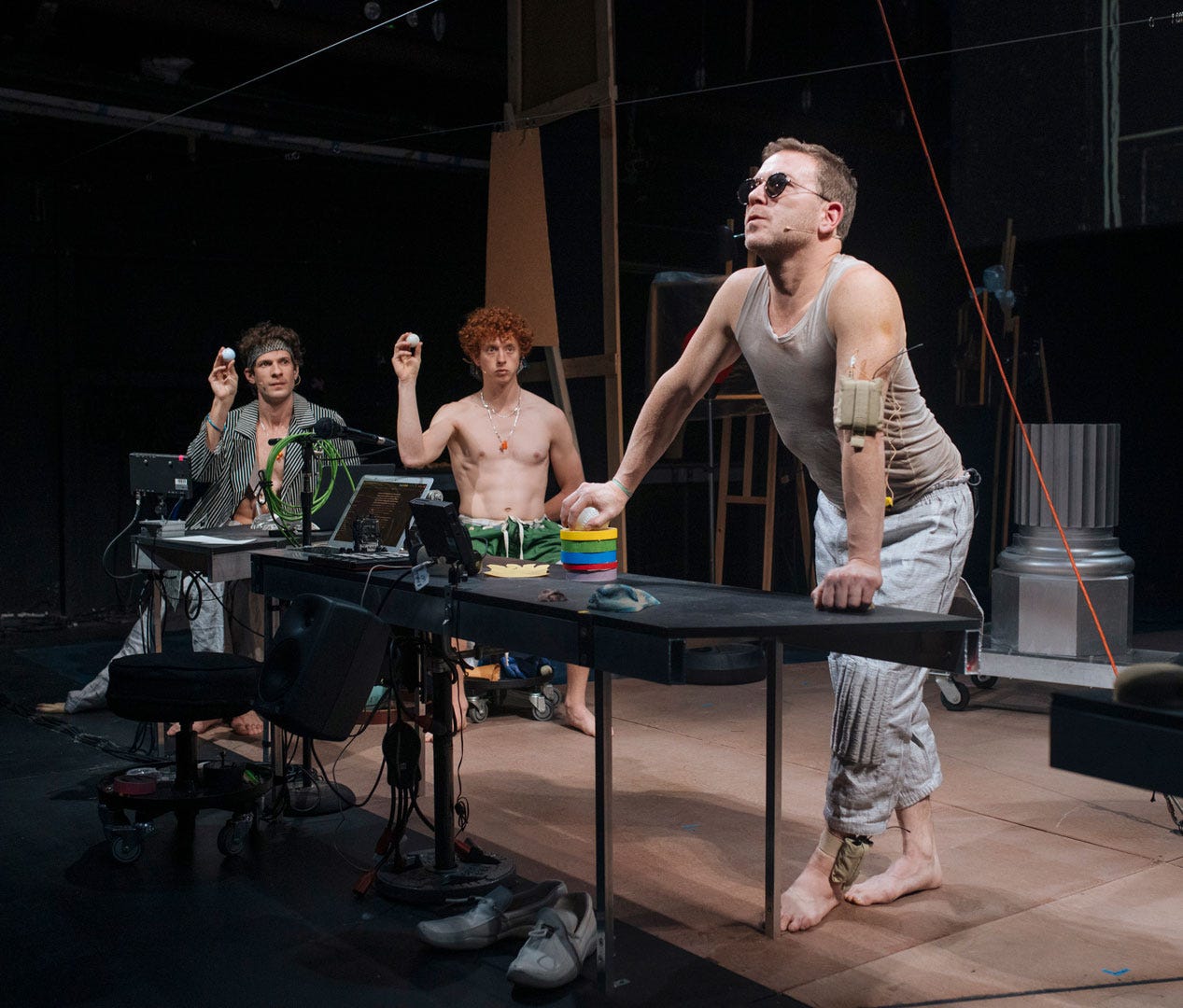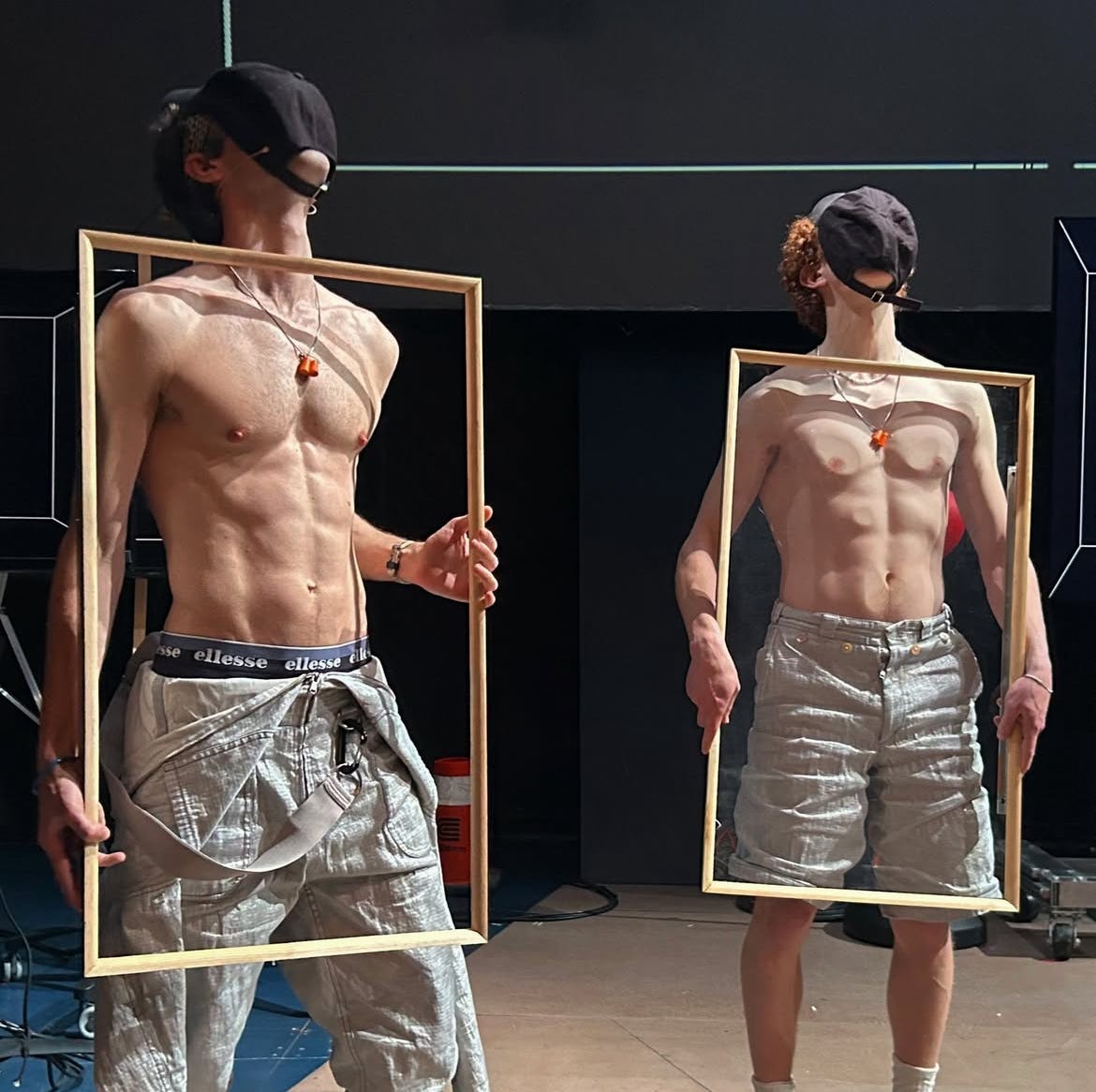Culture Vulture: the Wooster Group's SYMPHONY OF RATS
and ecstatic performances by Jamie XX and Arooj Aftab
The best show playing right this minute in New York City is the Wooster Group’s production of Richard Foreman’s Symphony of Rats at their home base in Soho, the Performing Garage, which seats about 75. Foreman, the founder of the Ontological-Hysteric Theater who died earlier this month at the age of 87, wrote the play for the Wooster Group to perform and directed the first production of it in 1988. Recently, the group decided to revive the play in a new production co-directed by longtime artistic director and resident genius Elizabeth LeCompte with Kate Valk, a founding member of the group who performed in the original production. Foreman encouraged them to “do whatever you want” with the play, which loosely concerns the President of the United States as he struggles to interpret messages he’s receiving telepathically.
Indeed, when the new production premiered last spring, it looked nothing like Foreman’s original production but looked very much like a Wooster Group production with its dense array of video technology, inscrutable props, wild yet precise performances, and a multilayered sound score with songs by Suzzy Roche. The show made a splash and got great reviews, which led to touring engagements in Los Angeles and Nashville. Now it’s back for a reprise run through February 8, and it’s better than ever – a dazzling, cartoonishly cryptic spectacle with even more music (a true symphony!). It’s a suitably cheeky fun-house mirror for our insane political moment.
Although Foreman’s texts can seem like a stream of non sequiturs, he always has a purpose in mind. In his introduction to the published play, Foreman describes Symphony of Rats as a political play. “The real politics of America have to do with the conflict between people who can sustain ambiguity in their lives, and people who are terrified by ambiguity and fight to reduce every issue to clearly defined choices, either black or white, and so become conservative reactionaries.” (You can watch a fascinating interview with Foreman filmed just last year by Steven Watson on his art-historical online archive Artifacts.)
The play doesn’t exactly have a plot but it does have plenty of incidents. The President (played by the group’s resident leading man, Ari Fliakos) broods in his chambers, surrounded by a trio of assistants, two handsome lads (Niall Cunningham and Andrew Maillet) and a mysterious bespectacled female in a black hat (Michaela Murphy) who attend to his intimate and excretory body needs. Meanwhile, the President conducts ongoing dialogues with a goofy sinister doctor (Jim Fletcher), an oracular dreadlocked guru (Guillermo Resto, sitting behind what could be a ring light, a mirror, or a portal into another dimension), and a disembodied figure with an electronically altered female voice who’s like a cross between Tinkerbell and a constellation in the sky. Tiny snatches of Hollywood movies fly by (Women in Love, Good Will Hunting, The Great Dictator, some gory action film I couldn’t identify). What we’re watching could be happening on a mad version of the Starship Enterprise. It could be taking place in the President’s imagination. He could be tripping his brains out. All of the above. Or none of the above.
When he originally conceived the play, Foreman imagined that the President would be played by Willem Dafoe, another founding member of the Wooster Group (and at the time LeCompte’s life partner). But then Dafoe was cast in Martin Scorsese’s The Last Temptation of Christ, which was the beginning of his departure from the group. Instead, the President was played by the charismatic Ron Vawter, another original member of the group along with Kate Valk and Peyton Smith, who played his assistants as vivacious, shimmying managers of a distinctly wacky office. In this new production, the role of President gives Ari Fliakos yet another chance to shine.
Do you know that name, Ari Fliakos? You should. He is one of the great undersung American actors of our time, right up there with David Greenspan. He and Kate Valk are both monstrously talented performers – skilled, attractive, flexible, physically free, unique, riveting to watch – who have devoted themselves to the Wooster Group, trained and sculpted and encouraged and magnificently utilized by Liz LeCompte. Fliakos came on the scene in 1999, playing a small role – literally a dog – in House/Lights, the group’s adaptation of Gertrude Stein’s Doctor Faustus Lights the Lights.
Year after year, decade after decade, he has grown and thrived and become a commanding performer whose charm, craft, and physical beauty would surely have earned him stardom by now if he chose to work in film or television. Instead, he has mostly appeared in venues like the Garage, St. Ann’s Warehouse, the Baryshnikov Arts Center, and similar theaters around the country and abroad, playing for audiences of 75 or 200 or 500 a night. Those audiences have been treated to spectacular performances in To You, the Birdie! (Phèdre), Poor Theater, Vieux Carre, and A Pink Chair (In Place of a Fake Antique), to name just a few of my favorites. And Symphony of Rats is right up there with the best of them.
I’ve been watching the Wooster Group since early 1979, when they were still affiliated with Richard Schechner’s Performance Group and started performing their earliest works as a trilogy called Three Places in Rhode Island. Those pieces – Sakonnet Point, Rumstick Road, and Nayatt School – centered on LeCompte’s collaboration with Spalding Gray, her partner at the time. The Performance Group morphed into the Wooster Group, which included Vawter, Dafoe, Valk, Smith, and designer Jim Clayburgh, who together created a string of amazing, challenging, controversial theater events, many of them bouncing off classic American plays (Our Town, The Crucible, Long Day’s Journey Into Night). Spalding Gray eventually went on to worldwide fame as a monologuist until his untimely death (suicide) in 2004. With the loss of Dafoe to Hollywood and Vawter to AIDS, the group underwent a sea-change, bringing Kate Valk to the forefront, saying goodbye to Peyton Smith (who left the theater for a quieter life in the Southwest), and adding two important new players, Scott Shepherd (who has divided his time between the Wooster Group and Elevator Repair Service) and Ari Fliakos, along with many young associates.
I wish I could describe the feelings that go on inside me when I’m watching a Wooster Group performance. I feel much the same way when I look at paintings by Jean-Michel Basquiat or when I’m on psychedelics. My body is humming with excitement. My brain is lit up. My need for logical rational storytelling goes offline; I’m ready for an adventure. I’m inhabiting an activated landscape bristling with nuance and controlled chaos, heightened sensory perceptions, luscious unpredictable sounds and visions, dense references from all over the cultural map. (Symphony of Rats abounds with balls of many sizes, including one that serves as an oblique homage to their departed colleague: a basketball bearing the logo Spalding.)
As a director, Foreman’s treatment of women was never especially enlightened, as you can tell from the rough reference videos that exist online of the 1988 production of Symphony of Rats. So it’s especially delicious to see the play recast and restaged by women, who clearly get a kick out of putting these guys through their wacky paces. The one live female performer and the disembodied female figure both maintain quite a lot of agency while retaining their mysteries – stand-ins perhaps for Valk and LeCompte? Meanwhile, the two young male assistants are slyly objectified for their nubile, sometimes shirtless bodies.
Because of the way they build their theater pieces under the direction of LeCompte (with Valk graduating from assistant to co-director), painstakingly over many months, rehearsing day after day, year after year, the performers have a shared commitment and ownership of the work that is thrilling to observe. Their work benefits from a deep familiarity with not only each other but with the battery of technology that LeCompte ingeniously deploys. They’re like a tight rock band or sports team or dance company.
The joy of watching them spoils me for other theater. Of course, I see stuff all the time, and sometimes it’s great, but much of it is just okay.
Maybe Happy Ending – sweet and inconsequential.
Death Becomes Her -- flashy and dumb.
English – smart, beautiful, stimulating.
The Civilians’ Radio Downtown, Sam Kissaujukian’s 300 Paintings – just okay.
The only shows I’ve seen lately that approached the ecstasy of Symphony of Rats were Jamie XX at Park Avenue Armory and Arooj Aftab at HERE.
Electronic dance music (EDM) has spawned an entirely new genre of live events, and Jamie XX represents the art form at its peak. It’s odd to think of what a DJ does as performing, but hovering at his deck Jamie XX cast a spell over a couple of thousand dancing fools with witty samples and sizzling grooves from his new album In Waves.
I felt incredibly lucky to snare a ticket to Arooj Aftab’s show at HERE as part of the Prototype Festival. She is definitely going places, and she won’t be playing intimate spaces like this (seating capacity: 71) again any time soon. This was my fifth time seeing her live, and as ever she gave sublime vocals and hilarious deadpan between-songs chat. She’d done a little research and was excited to learn that the theater downstairs at HERE was the birthplace of Eve Ensler’s The Vagina Monologues. “I’ve dated a lot of women over the years, and many of them were made…less crazy by seeing The Vagina Monologues.”
Most of her songs are in Urdu, and she usually doesn’t tell audiences what the words mean – “You should do your homework!” But she made it a point to say that “Rat Ki Rani,” the first single from her latest album Night Reign, describes that experience where you spy someone across the room at a party, you lock eyes, there’s clearly mutual interest…and then you leave and go home to your partner. “My partner hates this song,” she said drily. As is her wont, she distributed a couple of rounds of whiskey shots to the audience. Her band included Maeve Gilchrist, her ever-present wizard on harp, Engin Gunaydin on drums, and Zwelakhe-Duma Bell Le Pere on bass – as tight and loose as any great jazz combo and well-versed in her beautiful songs that go high and low and evaporate like smoke from the haze machine she takes wherever she goes.
If you are enjoying these posts, please consider becoming a subscriber. All eyes are welcome, and I especially appreciate paid subscriptions. They don’t cost much — $5/month, $50/year — but they encourage me to continue sharing words and images that are meaningful to me. If it helps, think of a paid subscription as a tip jar: not mandatory but a show of appreciation.











Great review. Thank you for capturing the inexplicable mental state of seeing the Wooster Group.
(And FYI the bloody fight scene was from the 2021 Marvel movie Suicide Squad, surely one of their most mainstream -- and contemporary -- video references in a while!)